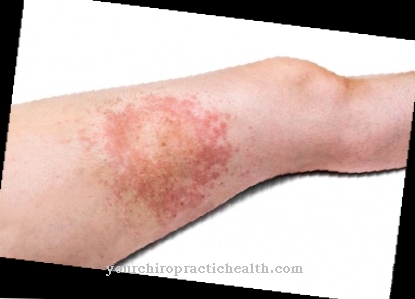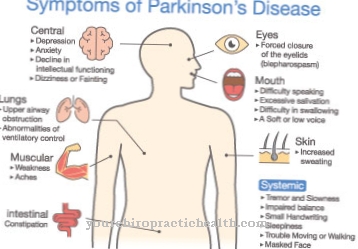As one House dust allergy or. House dust mite allergy I mean an allergic reaction to the excrement of house mites, which are mainly in beds and mattresses. In the course of the allergy, typical allergic symptoms such as watery eyes, coughing, itching and reddening of the skin occur.
What is a house dust allergy?

In the case of a house dust allergy or house dust mite allergy, the immune system of the person concerned reacts particularly sensitively to the faeces and residues of the house dust mite. The only 0.1 to 0.5 mm large arachnids live in 150 species worldwide and can be found in almost every household. The animals feed on dead skin cells and prefer to live in carpets, upholstered furniture, duvets, pillows and mattresses.
While the house dust mite is normally completely harmless, it causes a person with a house dust mite allergy to have a runny nose, allergic sneezing fits and itchy eyes, and more rarely a sore throat, itchy ears, itchy nose, cough and allergic asthma. Furthermore, a house dust mite allergy can begin with a more or less harmless runny nose and over the years take on asthmatic traits. Such a change in symptoms in a person with a house dust mite allergy is also called a change of floor in technical jargon.
causes
House dust mite allergies are caused by an allergic overreaction of the immune system. House dust allergy is a type I allergy, the so-called immediate type. Responsible for this is the P1 antigen allergen found in the faeces of house dust mites. Since those who cause house dust mite allergy feed on flakes of skin, they prefer to live where these flakes accumulate.
These are, for example, pillows, blankets, mattresses, upholstered furniture and soft toys, but also places where the dust and thus the flakes of skin persist for a particularly long time, for example in the curtains, carpets or on decorative objects, which are also known as so-called dust catchers for a reason are.
In the course of studies, it was reported that after around two years, around a tenth of the contents of a feather pillow consist of dead mites and their faeces. People with a house dust mite allergy should therefore take certain precautions to effectively reduce the effects of house dust mite allergy.
↳ More information: If you suspect an allergy to mites, you should get more information about the house dust mite and get to the bottom of the cause.
Symptoms, ailments & signs

The complaints and symptoms of a house dust allergy can be very different and also depend heavily on the severity of this allergy.
However, they generally reduce the quality of life of those affected considerably and lead to various restrictions in the patient's everyday life. Primarily those affected suffer from a house dust allergy from watery eyes and a strong cough.
The eyes often water permanently, whereby the tearing is often intensified by rubbing the eyes. Many patients also suffer from a runny nose and a constantly runny nose. Swelling may appear all over the body, which is made worse by inhalation of house dust. The skin itself is often affected by redness and can also itch.
As a result, those affected often suffer from reduced aesthetics and thus from reduced self-esteem or from inferiority complexes. The house dust allergy can therefore lead to mental upsets or to depression. In severe cases, this allergy can lead to shortness of breath, in which the person concerned can lose consciousness or even die. However, this case occurs only very rarely, so that life expectancy is usually not negatively affected by this allergy.
Complications
A house dust allergy does not usually lead to major complications. Contact with the allergen can lead to coughing and sneezing fits, runny nose and sore throat or headache, which, however, quickly subside. However, if contact with the allergen remains for a longer period of time, an increased willingness to asthma can develop.
In the further course, a house dust allergy can then go through a so-called change of floor and lead to chronic asthma and the development of further allergies. Babies, toddlers, and those with severe allergies can also experience anaphylactic shock. In the long term, a house dust allergy can also cause some secondary diseases.
Sinus infections, larynx infections and hay fever are typical. The treatment of a house dust allergy via desensitization is also associated with risks and complications. As part of the treatment, complaints such as exhaustion, tiredness or headaches occur, which usually persist for some time and can temporarily worsen the original allergy.
In addition, the vaccination can lead to allergic reactions such as wheals, shortness of breath or even cardiac arrhythmias. An allergic shock can rarely occur after a desensitization.
When should you go to the doctor?
Sudden swelling of the mucous membranes, nasal speech, or nasal congestion should be examined and treated by a health professional. The reduction in symptoms as soon as the local conditions change is particularly striking.
If your eyes are watery or reddened, or if they are itchy, it is advisable to consult a doctor. If there is a change in breathing over several days or if it occurs repeatedly in apartments or other indoor spaces, a doctor should be consulted.
If you plan to stay overnight, you should check the circumstances before going to sleep so that breathing does not stop during the night. Particular caution is required if breathing becomes difficult. Depending on the intensity, an emergency doctor must be called. Until the rescue service arrives, first aid measures must be taken and the patient must be ventilated. If a rash develops, persistent coughing or runny nose as well as sneezing attacks, a doctor's visit is necessary.
In some patients, under certain conditions, there may be a sharp increase in symptoms within minutes. You should go outside immediately. If an anaphylactic shock occurs, an ambulance service must be called. The instructions of the employees must be followed until the doctors arrive, as otherwise the person concerned may die.
Doctors & therapists in your area
Treatment & Therapy
Treating a house dust allergy is relatively difficult. Curbing the symptoms caused by house dust mite allergy primarily requires reducing the number of allergenic substances. This is very difficult to achieve in practical use. Nevertheless, there are attempts to reduce house dust mite allergy through specific immunotherapy, but this often only brings the desired success if it is carried out early.
With such a desensitization, the overreaction of the immune system to an allergen is reduced. This happens because the allergy sufferer regularly ingests high doses of the allergen causing the house dust allergy, so that the immune system is adapted to come to terms with the substance that triggers the house dust mite allergy instead of overreacting. As a result, the exposure to house dust mite allergy is lower, although the sensitization to the allergen in question is still present.
Outlook & forecast
House dust allergy sufferers have a chronic disease that lasts for life. The symptoms of hypersensitivity can be easily treated with the current medical options, so that the allergy can be dealt with effectively on a daily basis.
The methods of desensitization or desensitization show good results and alleviate the patient's symptoms to a considerable extent. An additional change in the everyday conditions in the living room and bedroom of the person concerned can reduce the symptoms that occur to a minimum.
This optimizes the quality of life despite the disease. The lifespan of an allergy is usually not shortened. As soon as adequate precautions are taken and there is no anaphylactic shock, the patient has a good chance of leading a comfortable life with the house dust allergy.
If the restructuring measures and the medical treatment are not used, the complaints can increase. In addition, the patient is threatened with a life-threatening condition. As an alternative to medical treatment, the patient can use various natural therapies to alleviate the symptoms. They also reduce symptoms and improve health. To support this, the everyday environmental conditions should also be optimized here so that the general exposure to mite excrement is reduced.
prevention

A house dust allergy can be mitigated by various preventive measures. For example, when vacuuming, you should make sure that not too much dust is blown up.
Devices with a HEPA filter and special central vacuum systems are particularly suitable for people with a house dust mite allergy. Furthermore, the air humidity should be kept as low as possible through regular ventilation, since the mites that cause house dust mite allergies feel most comfortable in a warm and humid climate.
In addition, the curtains and other dust catchers should be removed. This also applies to the soft toys in the beds of allergy-prone children. Carpets should be replaced with wooden, cork or plastic floors and feather bedding should be exchanged for special allergy-free bedding. Dusting is to be avoided and instead it is better to wipe with a damp cloth, whereby the water can possibly also be enriched with a fungicidal agent, since the mites that trigger house dust allergies depend on the presence of certain fungi.
Aftercare
The extent to which follow-up care is necessary depends heavily on the severity of the house dust allergy. Symptoms usually appear for a lifetime. Above all, it helps to reduce the number of mites. Those affected bear a great deal of responsibility for this. Suitable measures relate primarily to the bedroom. The bed linen must be changed regularly.
Dust traps such as curtains and carpets must be removed. It is recommended to wipe with a damp cloth at short intervals. If pets are present, they are not allowed to enter the sleeping area under any circumstances. It is not uncommon for hypersensitization to be carried out to stop the house dust allergy from recurring. Patients are given doses of the allergen for several years.
This is supposed to get you used to it. For many sufferers, this leads to relief. In addition, there are a number of drugs that only work for a short time. To avoid discomfort, those affected should take them acutely. You should take them with you, especially when traveling. Coughs and runny nose can be alleviated with sprays and solutions.
Prescription ointments and over-the-counter creams are suitable for reducing reactions on the skin. People with a severe form of the disease should regularly see a specialist who will document the progress of the disease.
You can do that yourself
People with a house dust allergy can take various measures to alleviate the symptoms.
A damp, cold washcloth that is placed on the affected eye for about five minutes can help with reddened and itchy eyes. If you have a cough, a short walk in the fresh air is recommended. Then the bedrooms should be ventilated and vacuumed. Since dust mites predominantly reproduce in humid areas, care should be taken to ensure that the room climate is relatively dry and not too warm.
It is important to avoid dust traps in the home. This includes books as well as large curtains and deep-pile carpets. Ideally, the relevant objects are sprayed with a product from a specialist retailer and cleaned regularly. The mattress is best covered with a suitable cover. The bed linen should be washed regularly at high temperatures (60 to 95 ° C) and also provided with mite-proof covers.
Dietary measures also help. Allergy sufferers should eat as rich in vitamins and minerals as possible and also drink a lot and regularly. If these measures do not show any effect, you should see a doctor with the house dust allergy. Usually the suffering can be counteracted by desensitization.
















.jpg)
.jpg)



.jpg)






